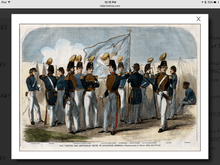Republican Blues
| Republican Blues | |
|---|---|
 Distinctive Unit Insignia: 118 FA | |
| Active | 1808–present |
| Country |
|
| Allegiance |
|
| Branch |
|
| Type | Artillery |
| Size | Brigade |
| Garrison/HQ | Savannah, Georgia |
| Nickname(s) |
Blues (special designation)[1] Lightning Brigade (former) |
| Engagements |
War of 1812 American Civil War World War I World War II Iraq Campaign Afghanistan Campaign |
| Decorations | Presidential Unit Citation, Meritorious Unit Commendation, French Croix de Guerre with Palm, Luxembourg Croix de Guerre, Belgian Fourragere |
| Commanders | |
| Notable commanders |
Robert H. Anderson John Wayne Anderson George Wayne Anderson |
The Republican Blues were a military company formed in Savannah, Georgia. The Blues were first organized in 1808 and served at Fort Jackson and in Florida during the War of 1812. The Blues, typical of Savannah's old military units, were a fraternal social organization and a well-trained military unit. The Blues defended Georgia's coast from the Union Navy between 1861 and 1864. Unlike most Confederate units formed during the Civil War, the Republican Blues had been an existing militia organization for over fifty years before the war started. They recruited from the most prominent families in and around Savannah. They fought in all the nations wars after The Civil War as part of the Georgia National guard, with the lone exception being The Spanish-American War. Today they remain in service, as a modular artillery brigade of the Georgia Army National Guard, the 118th Field Artillery.
As part of the 48th Infantry Brigade, the 118th FA is of the oldest units in US Army history. It is one of few units in the US military that also saw service as a unit of the Confederate States of America during the US Civil War.
History and lineage
The Republican Blues were originally organized in 1808, at Savannah, Georgia. It mustered into Federal service in June 1812, in Florida.
The unit was brought into Confederate service on 20 April 1861 at Savannah, GA and was reorganized and redesignated on 22 April 1861 as Company C, 1st Battalion, Georgia Infantry. The Blues joined eight other companies of Savannah militias to form the First Volunteer Regiment of Georgia. At the order of Governor Joseph E. Brown to occupy strategic Fort Pulaski, Commander of the Regiment, Colonel Alexander R. Lawton, and his adjutant Charles Olmstead would plan and execute the first act of rebellion in the state of Georgia, On January 3, 1861 a force of 134 men and 6 artillery pieces landed at the deserted fort, and raised the red star of Georgia for the first time. Most of the force was made up from men from the Savannah Volunteer Guards, the Chatham Artillery, Georgia Hussars, and the Oglethorpe Light Infantry. More than three months before Fort Sumter, Georgia took the first action.
Assigned to strategic Fort McAllister in 1862,[2] they repulsed more than seven US Naval attempts to capture Fort McAllister, which protected Savannah. They successfully fought off Union ironclads, winning the praise of Confederate generals and congressmen. In May 1864, the Blues left Fort McAllister to reinforce Confederate Gen. Joseph E. Johnston's army in northern Georgia. After Union Maj. Gen. William T. Sherman's forces captured Atlanta, The Blues went into Tennessee and fought in the Battle of Nashville. It was during this time when the Blues began to show signs of war weariness. The Blues later marched into the Carolinas and surrendered to Sherman's army in the spring of 1865 in North Carolina. The unit was reorganized and federally recognized 29 November 1920 in the Georgia National Guard at Savannah, Georgia.
From 1945 to 1973, the unit underwent a series of redesignations culminating in its current form, as part of the 48th Infantry Brigade. It reorganized and was federally recognized 12 December 1946 as an element of the 48th Infantry Division.
Gallery
 Republican Blues in 1860
Republican Blues in 1860 GA Savannah Fort Jackson pano01
GA Savannah Fort Jackson pano01 GA Savannah Fort Jackson gate01
GA Savannah Fort Jackson gate01 GA Savannah Fort Jackson04
GA Savannah Fort Jackson04 Georgia Flag at Fort James Jackson
Georgia Flag at Fort James Jackson- Fort McAllister Now 01
- Fort McAllister Now 04
- Fort McAllister Now 08
 GA Richmond Hill Fort McAllister Tom Cat marker01
GA Richmond Hill Fort McAllister Tom Cat marker01 USS Montauk Attacks Fort McAllister
USS Montauk Attacks Fort McAllister
References
- ↑ "Special Designation Listing". United States Army Center of Military History. 21 April 2010. Archived from the original on 9 June 2010. Retrieved 14 July 2010.
- ↑ Christman, p. 16
- Dixon, William Daniel and Durham, Roger S, The Blues in Gray - The Civil War Journal of William Daniel Dixon and the Republican Blues Daybook, University of Tennessee Press, 2000, ISBN 978-1-5723-3101-3
- Durham, Roger S., Guardian of Savannah - Fort McAllister, Georgia, in the Civil War and Beyond, The University of South Carolina Press, 2008, ISBN 978-1-5700-3742-9
- Christman, William E., UNDAUNTED: The History of Fort McAllister, Georgia, Darien Printing & Graphics, 1996, Library of Congress Catalog 96-77666 ASIN:
- Smith, Derek, Civil War Savannah, Frederic C. Beil, 1997, ISBN 978-1929490004
External links
- Republican Blues Marker at Fort Jackson, GA
- About Us: 48th Infantry Brigade Combat Team
- Rules and Regulations of the Republican Blues
- NY Times article on visit to New York in 1860